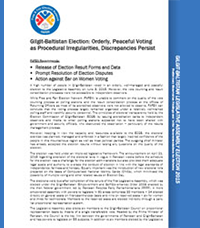- Women in Gumari area of Darel Valley Barred from Voting
- FAFEN Stopped from Observing Vote Counting Process
ISLAMABAD, June 10, 2015: The election to the Gilgit-Baltistan Legislative Assembly on June 8, 2015 witnessed an impressive turnout of voters in a peaceful and well-managed polling process. However, the vote counting and result consolidation processes were not accessible to independent observers, says Free and Fair Election Network (FAFEN) in its preliminary observation report on Wednesday.
Despite an efficient accreditation process by the Election Commission of Gilgit-Baltistan (ECGB), the principles of electoral transparency appeared not to have been shared with the government and security officials, who obstructed FAFEN’s observers – particularly of the results consolidation process.
As many as 30 FAFEN observers were obstructed either by the polling officials or by security personnel deployed at the polling stations. Due to the heavy presence of army personnel and police officials inside and outside polling stations, FAFEN observers faced difficulties entering the polling stations. The security officials did not allow FAFEN observers to observe the polling and counting process at 22 polling stations, while election officials barred the observers at another five polling stations.
In line with its mandate to observe the elections and advocate for electoral reforms for transparent, accountable and responsive elections, FAFEN deployed 183 trained citizens to observe more than 700 out of 1,151 polling stations.
FAFEN observers were trained on technical aspects of the voting and counting process. Each observer was required to observe at least four polling stations to ensure optimum outreach and in-depth assessment of the quality of the electoral process. The observers were trained to fill out standardized checklists based on laws and rules to optimize objectivity and ensure uniformity of observations. The preliminary findings are based on initial reports obtained from 159 polling stations in 20 constituencies.
As many as 13 political parties fielded their candidates to contest 24 Legislative Assembly seats in seven districts of the region. However, the number of women contestants for the general seats remained low, as only five women were in the contest for six seats. PPPP and PTI gave one ticket each to women candidates, while three women candidates contested independently. The PTI candidate contested for two seats in Ghanche district.
Despite the adoption of the Representation of People Act 1976, the final list of polling stations was neither gazetted by the respective DROs nor was it published and distributed among the contesting candidates and other election stakeholders.
Election Day complaints were registered with ROs in five constituencies. The presiding officers in GBLA-13 (Astore-I) complained that voters were not aware of the election symbols allotted to the contesting candidates and that female voters were totally unaware of the voting process. In the same constituency, JUI-F and PTI registered complaints that the voters at certain polling stations were being forced to vote for some candidates, while an independent candidate complained that unauthorized persons were present in some polling stations of the constituency.
Political parties also accused the polling staff of favoring certain political parties at some polling stations of GBLA-3, Gilgit-III. Similarly, independent candidates, along with political parties, complained that the voting process was progressing too slowly and that the RO did not allow the candidates to visit polling stations in GBLA-21, Ghizer-III.
Although the overall quality of elections in Gilgit-Baltistan was better compared to the election quality in other regions of Pakistan, some inconsistencies in implementation of voting processes were visible.
Polling staff continued to overlook important steps, such as filling and stamping the counterfoils and marking the back of the ballot with official stamp and signature which may render a vote objectionable and lead to the rejection of vote during the counting process.
Presiding officers allowed some polling agents to sit and observe the polling without candidate’s signature on their authority letter while others were not allowed to do so. Similarly, there were several polling stations where the secrecy screens were set in a manner that polling agents and/or polling staff could see the voters stamping the ballot. In addition, army personnel stood too close to the secrecy screen, which again compromised the secrecy of the ballot.
Political parties and contesting candidates were freely breaching the legal restriction of no canvassing within a 400 meters radius around polling stations. At 73 polling stations political parties and independent candidates had set up camps very close to the polling stations. Campaigning and canvassing of voters went on freely at these camps, with no action reported from anywhere to curb these activities.
FAFEN observers reported at least 11 combined polling stations where only one polling booth was established for both the male and female voters, in violation of statutory requirements. Four such instances were reported in Ghanche and Skardu, in addition to three instances in Hunza-Nagar where observers reported that the presiding officers had established one polling booth for both male and female voters.
Furthermore, the presiding officers at these polling stations divided the time for polling such that the male voters would vote during the first four hours while the female voters would vote during the latter half of the day.
The ECGB did not set up any combined polling station in the entire Diamer district. Although appropriate staffing was made at female polling stations, initial reports suggested that the local communities continued with their decadent practice of disenfranchising women in many polling areas. For instance, women in Gumari area of Darel valley were barred from voting. Some other yet unconfirmed reports suggest women voting took place only at a few polling stations.
To download the complete report on FAFEN’s preliminary observation findings, click here


